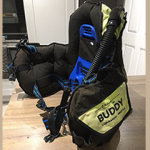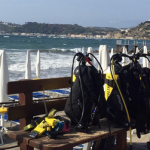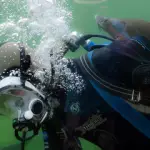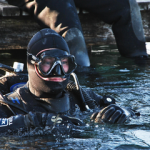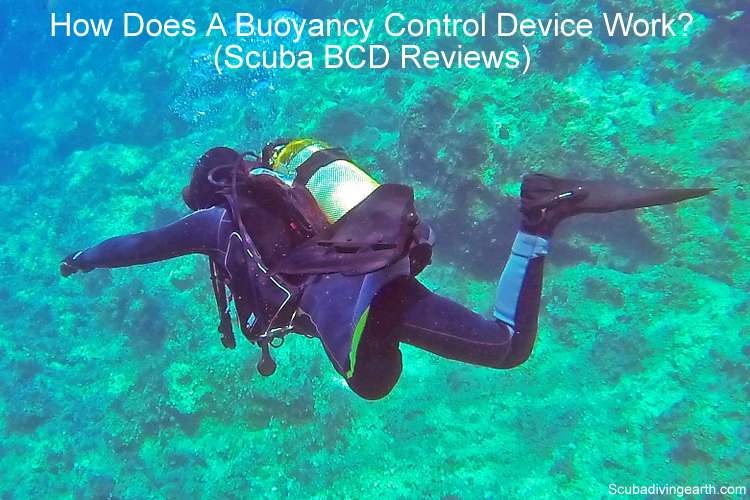
Without knowing how a buoyancy control device works you shouldn’t go scuba diving
There are essentially three stages to any scuba dive where the buoyancy control device (BCD) takes a crucial role. These three stages are covered in this article, along with how your buoyancy control device works.
How does a buoyancy control device work is by using air. Your buoyancy control device or buoyancy compensator works using an inflatable air bladder. The more air that is added to this inflatable bladder, the more buoyant you will be. Conversely, as the air is released from the air bladder, the less buoyant you will be. Air is added via an air-inflation valve. Air is dumped via air-deflation valves.
The best way to do more diving and to improve your buoyancy control skills is to book yourself on a scuba diving liveaboard. You can check the latest and best deals on liveaboards using the following window:
What do the initials BCD stand for?
Firstly, before I explain how a buoyancy control device works, what do the initials BCD stand for. The ‘B’ is for buoyancy; the ‘C’ is for control; and the ‘D’ is for device.
A buoyancy control device (BCD) is one of the most important pieces of equipment a scuba diver uses. Without which you wouldn’t be able to achieve neutral buoyancy, which is explained further down in this article.
There are different types of BCD on the market, but the principle of how they all work is the same. Other common names for a buoyancy control device include a buoyancy compensator, BCD or a what I tend to use a stab jacket.
Why is it important to know about buoyancy?
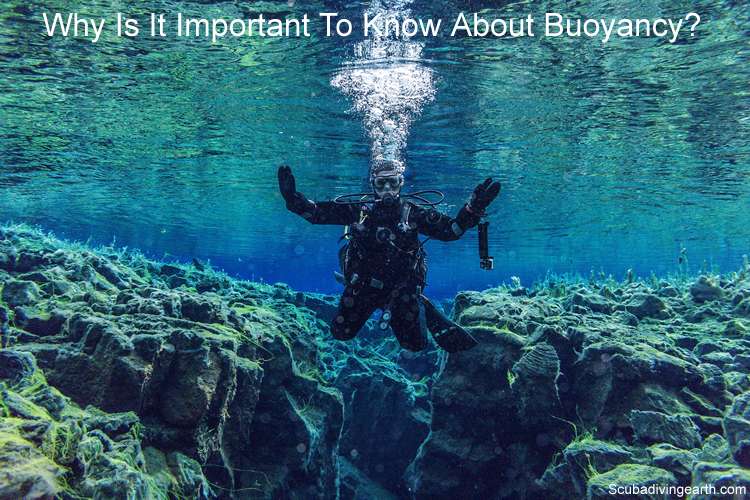
When you learn to scuba dive, there are a number of principles you will need to learn. One such principle is buoyancy.
Buoyancy (or also known as buoyancy force) is the upward force that’s exerted on an object that is wholly or partly immersed in fluid. Where in our case the fluid concerned is water. Buoyancy acts in an upwards direction on scuba divers and buoyancy is caused by differences in pressure acting upon opposite sides of them as they are immersed in water.
When you are less buoyant than water, the upward pressure is greater than the downward force of you and your equipment. In which case you will float. But when you are negatively buoyant, the downward pressure of you and your equipment is greater than the upward pressure of the water. In which case you’ll sink.

Archimedes principle
The Archimedes principle is where the magnitude of the buoyant force on an object is equal to the weight of the fluid it displaces. This is the principle applied to why boats and ships float. The magnitude of amount of water they displace around their hull is greater than the weight or downward force of the boat or ship itself.
How does a buoyancy control device work
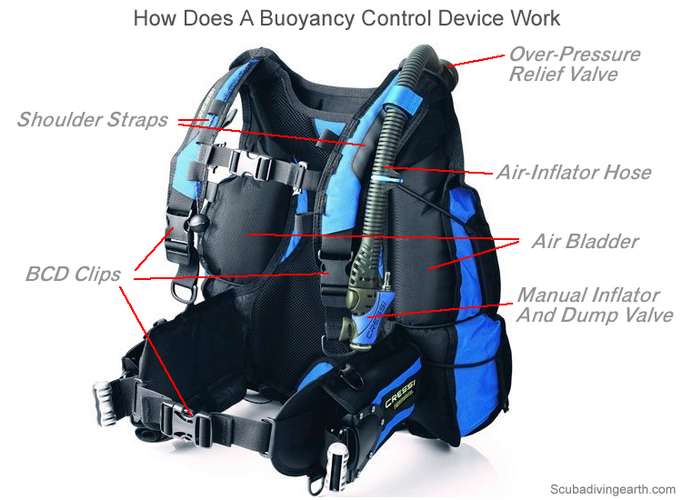
With the controlled inflation or deflation of your buoyancy control device with air, you are able to increase or decrease your level of buoyancy throughout your dive (see below for the stages in a scuba dive and the levels of buoyancy).
Your buoyancy control device works using an air bladder. The more air that is added to this bladder, the more buoyant you will become. Conversely, as the air is released from the air bladder, the less buoyant you will become.
Your buoyancy control device is connected to your air tank via a direct feed. This direct feed is connected to the low pressure side of the first stage, which is attached to your air tank.
When you need to become more buoyant, you simply press the air-inflation valve to let more air into the bladder.
This is always best done in small amounts to avoid over inflation of the air bladder inside the buoyancy device. If you over inflate your buoyancy control device, you will become too buoyant and float to the surface. Unless of course you correct the over-inflation by dumping the excess air using the air-dump valves.
To reduce the amount of air in the bladder or BCD, you need to release air using one of the dump-valves or air-deflation valves. As with adding more air, you need to control the amount of air released.
Only let out small amounts of air each time to slowly decrease your buoyancy in a controlled manner. If you dump too much air from your buoyancy control device, you will become too negatively buoyant and descend to the bottom. Unless you correct this by adding more air using the air-inflator valve.
Can you over-inflate your buoyancy control device?
All buoyancy control devices have a safety valve (or an over-pressure relief valve) to prevent you from over-inflating them. The safety valve or over-pressure relief valve will release or dump any excess air when you add too much. This avoids any damage to the air bladder inside the BCD.
So the answer to ‘can you over-inflate your buoyancy control device,’ is no you can’t. Unless of course the safety valve is damaged and not working. As with all your equipment, you should have your buoyancy control device checked and maintained too.
During your dive, you should never rely on this safety valve. If you’ve put that much air in your buoyancy control device where the safety valves is dumping air, you’ve put way too much air in your BCD. If you were to do this, it’s likely you’ll come rushing to the surface. This would become a very dangerous situation for you.
The three stages of a scuba dive?
Your buoyancy and how buoyant you need to be will depend on what stage of your dive you are at.
There are three stages of a scuba dive, which include: The descent when you need to be negatively buoyant; bottom time when you need to be neutrally buoyant; and the ascent when you need to be positively buoyant. At each stage in the scuba dive, the buoyancy control device or BCD plays an important role.
Your state of buoyancy is in direct proportion to the water that surrounds you.
Throughout the dive you will need to manage the amount of air in the air bladder to correct and control your buoyancy at each of these three stages.
Understanding the three stages of a scuba dive
- The descent – controlled negative buoyancy is required.
- Bottom time – controlled neutral buoyancy is required.
- The ascent – controlled positively buoyancy is required.
For each one of the above three stages of your scuba dive, the buoyancy control device is a key part of your scuba diving equipment.
Let’s take a look at each one in a bit more detail.
The descent stage of a scuba dive – when controlled negative buoyancy is required
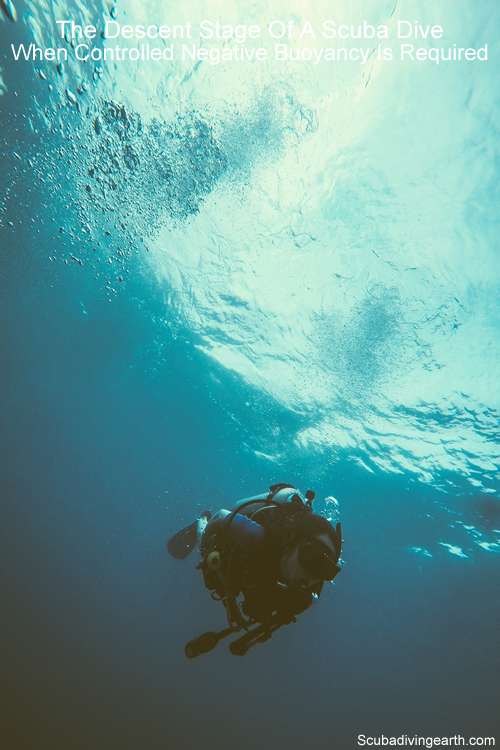
To understand scuba diving, it’s first important to understand that water is more buoyant than air. Most people float in water, which is why we can swim on the surface.
But the idea with scuba diving is that you sink below the surface. Otherwise you’ll end up snorkeling on the surface instead.
The equipment you take on a scuba dive is mostly negatively buoyant (i.e. it sinks). But when we look at body insulation, for example a wetsuit or drysuit protection, these add to your buoyancy.
More Reading: Does a dry suit keep you dry (What are the exceptions & do you get wet)
To compensate for the added buoyancy of a wetsuit or dry suit, you need to add a weight belt to your equipment. In other words, at the surface you need to be slightly negatively buoyant, so that you can commence your descent.
All divers are different shapes and sizes. As a result everyone has a different starting buoyancy. Therefore every diver will require a different amount of weight to initially compensate their state of buoyancy to achieve a slightly negative buoyant state.
How do you descend in scuba diving?
But you may then ask why you need a buoyancy control device for the descent. The reason for this is because as you descend, the air pockets in your body, in your equipment and in the neoprene on your wetsuit become compressed. This compression creates more negative buoyancy, thereby making you more negatively buoyant.
The deeper you go, the more negatively buoyant you become. The more negatively buoyant you become, the more air you’ll need to add to your buoyancy control device to compensate.
To avoid descending like a stone and to compensate for becoming more negatively buoyant, you need to add more air to your buoyancy control device. By adding air on your descent, you slowly control how fast you descend. If you didn’t add air to your BCD on your descent, you would descend faster and faster.
As you approach the bottom, or if you are diving where you’re not going to reach the bottom, you need to slowly add sufficient air to your buoyancy control device to achieve a state of neutral buoyancy during your descent. This leads to the second stage of a scuba dive, which is bottom time.
The bottom time stage of a scuba dive – when neutral buoyancy is required
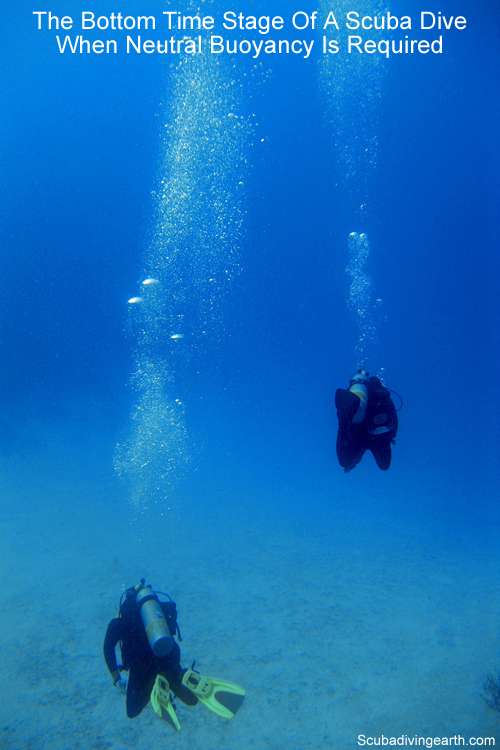
When you reach your required depth of your dive, you want to be in a state of neutral buoyancy.
This means you will stay at one depth and that you are the same buoyancy as the surrounding water at the depth you are at.
You are better to control this state and to slowly achieve neutral buoyancy on your descent, as describe above. Then so long as you remain at roughly the same depth, your buoyancy doesn’t need to change and you will remain at that depth.
But if during your bottom time you change your depth, either to go slightly deeper or slightly shallower, you will need to adjust the amount of air in your BCD accordingly.
For example, if you go slightly deeper you will become more negatively buoyant, so you will need to compensate for this by adding more air to the bladder in your BCD.
Whereas if you go slightly shallower your buoyancy will increase and you will need to dump some air from your buoyancy control device, to reduce your buoyancy.
Every time you either add air to or dump air from your BCD, this should be done in small amounts and in a controlled manner.
That way you will use the least amount of air in the process. You want to conserve your air as much as possible, as you also need it for breathing. That way your dives will last longer.
Mastering neutral buoyancy can take time and practice. Don’t worry if you can’t master this when you first start diving. It will come over time as you increase the numbers of dives you do and with the experience you gain.
The ascent stage of your scuba dive – when positive buoyancy is required
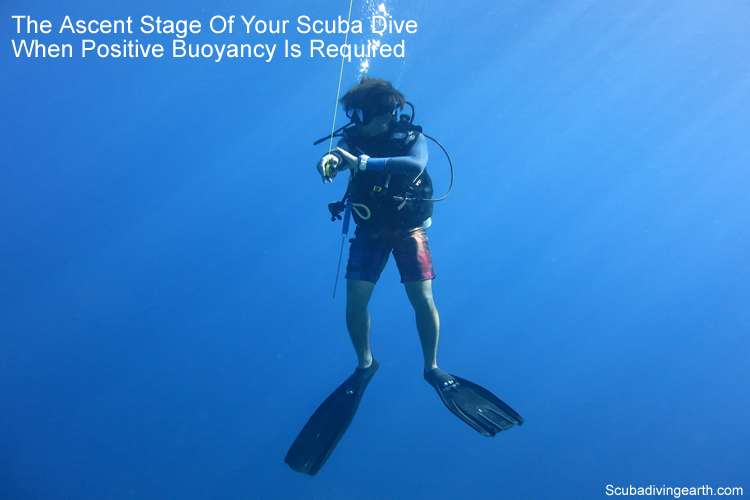
When you ascend from your scuba dive you will become more buoyant, as the air pockets in your body, your equipment etc. expand once more. As this happens you will become more buoyant. As you become more buoyant, your speed of ascent will increase. If you don’t control your speed of ascent, this can be dangerous.
How do you ascend when scuba diving?
In order to control your ascent, you need to dump some of the air that’s in the bladder of your buoyancy control device. As the air in the BCD bladder will be expanding too and adding to your buoyancy.
As you ascend, you must release small amounts of air from one of the dump valves on your buoyancy control device. But you mustn’t release too much, as you want to remain slightly positively buoyant in order to continue your ascent.
If you let too much air out of your BCD, you will either begin to descend again or you’ll need to use your fins to ascend. It’s much better to use your positive buoyancy to assist your ascent, rather than having to resort to finning yourself to the surface. You’ll use up less energy and less air that way.
Controlling your ascent speed is key to your safety
One of the dangers of scuba diving is getting decompression sickness (DCS). Decompression sickness is caused by the formation of small nitrogen bubbles in your body. This occurs as a result of coming up too fast or as a result of not performing decompression stops at the right intervals.
It is because of DCS that you must control your ascent carefully. This will prevent you from getting decompression sickness, plus allow you to stop at the appropriate times on your way up. I also always recommend a safety stop at around 5-6 metres (16-20 feet) too. It becomes almost impossible to stop at this depth if you are coming up too fast.
The secret to a controlled ascent is letting out consistent and small amounts of air from the air-bladder of your BCD.
Using your buoyancy control device for positive buoyancy on the surface
Once you’re on the surface you can use your buoyancy control device for positive buoyancy.
If fact during your training, you should be advised to use your BCD to provide positive buoyancy at the surface. Once your head is above the surface, you are best to completely fill your buoyancy control device with air. That way you will be as buoyant as you can be.
This will make it easier for you to keep your head above the water, until you reach the boat or the shoreline.
You should also fill your buoyancy control device with air before you jump into the water. This is important to make sure you bob up to the surface after you first jump in. That way you’ll be able to compose yourself before you commence your dive. It will also allow you to meet up with your dive buddy or dive party before you descend.
At the surface, and to conserve air, you are better off using your own breath to fill your buoyancy control device. This can be done via the manual inflator using the mouth piece that’s connected to the inflator hose.
How do you get neutral buoyancy?
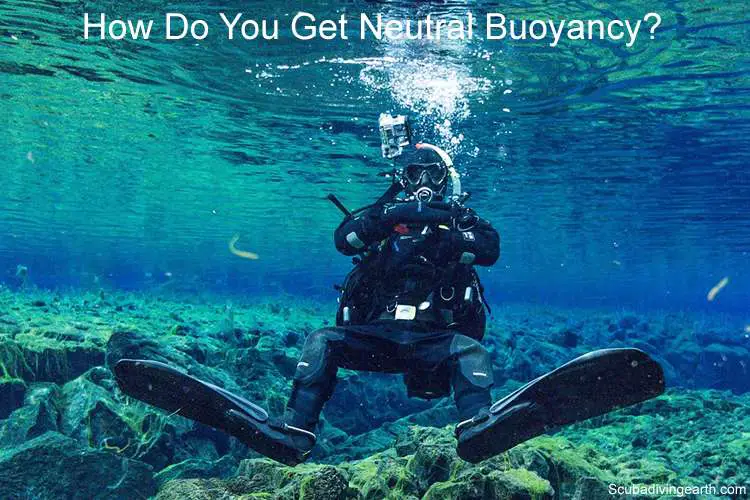
Firstly, before I explain how do you get neutral buoyancy, it’s first important to understand what is neutral buoyancy?
Neutral buoyancy is a condition in which a diver’s average density is equal to the density of the water in which they are immersed. In other words, they are the same weight as the water they are displacing at the depth they are at.
As already mentioned, it’s important to become neutrally buoyant so you can enjoy the dive and remain at a certain depth. If your buoyancy isn’t correct, you’ll end up using more energy to stay at that depth.
For example, if you’re too negatively buoyant (i.e there’s too little air in your BCD), you will be constantly finning to stay at your depth and to avoid descending to the bottom. But if you are too positively buoyant (i.e. there’s too much air in your BCD), you will be constantly fighting to stay down.
In both these cases you will end up using more air than you need to on your scuba dive. You only have a limited amount of air when you dive, that is what’s in your air tank, so you want to conserve it as much as you can.
Buoyancy is about controlling small amounts of air
To obtain neutral buoyancy you need to add just enough air to your buoyancy control device so that you are neither negatively buoyant nor positively buoyant.
The best way to achieve neutral buoyancy is by adding very small amounts of air to your BCD at a time. However, this could be that you need to dump some air if you are too positively buoyant. But as with adding air, you must also dump air in small quantities too. Otherwise you may dump too much air and sink to the bottom, resulting in you needing to add more air once more. This wastes you air supply, giving you less air to breath and consequently less dive time.
You will find that as you gain more experience scuba diving, the process of achieving neutral buoyancy get easier and easier. You start to get a sense of how much air and of your buoyancy state in the water.
Why is buoyancy important for scuba divers?
One of the most important concepts to grasp for anyone new to diving, is the the concept of conserving air when scuba diving. One of the best ways to conserve your air is to master buoyancy control and to master the art of obtaining neutral buoyancy.
Your ability to maintain neutral buoyancy at any stage during a dive will enable you to consume less air and conserve energy. As you progress through your levels of certification and start to dive deeper, this concept becomes even more important too. The deeper you dive, the more air you consume.
The better you are at managing your air consumption and your buoyancy control, the longer your dives will become.
I hope you enjoyed this article about how does a buoyancy control device work
I’d love to hear from you. Tell us about your adventures of diving and snorkeling, in the comments below. Please also share your photos. Either from your underwater cameras or videos from your waterproof Gopro’s!
If this article hasn’t answered all of your questions. If you have more questions either about snorkeling or scuba diving (or specifically about how does a buoyancy control device work), please comment below with your questions.
There will also be many more articles about scuba diving (and snorkeling) for you to read and learn about these fabulous sports.
Have fun and be safe!

